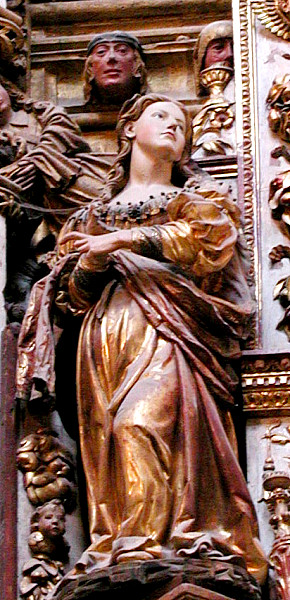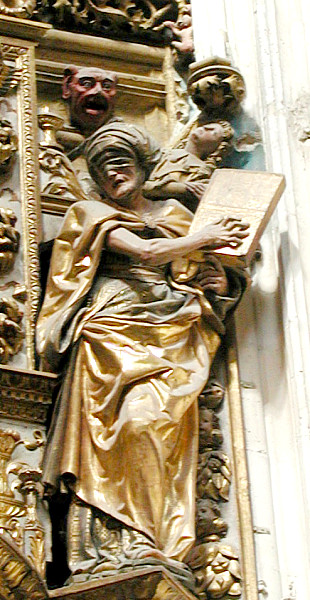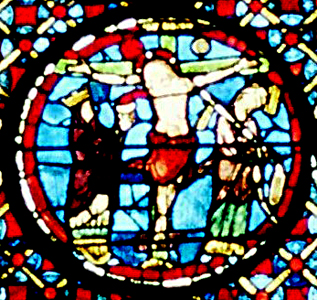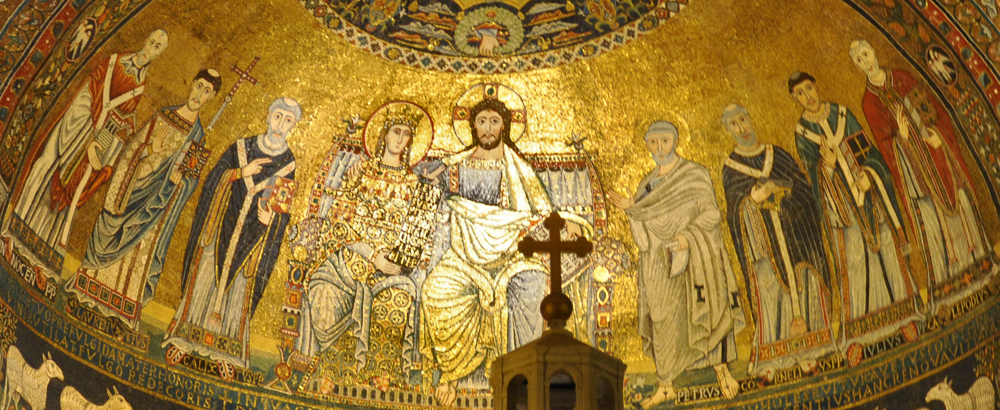Within this iconographic tradition there are two main image types. The first contemplates the Church as the bride from the Song of Solomon. The other juxtaposes the Church with what Christians considered her predecessor, the Synagogue.
THE CHURCH AS BRIDE OF CHRIST
Christian commentators on the Song of Solomon understood the bride allegorically as the Church. (See this page for an extended example in an illuminated manuscript.) The intimate language of the Song represented Christ's love for his bride and sometimes led to a fairly intimate iconography that portrayed the kisses and embraces of the bride and bridegroom.1 Another tradition in the art merged the Church and the Virgin Mary into a type known as Maria Ecclesia, as in the 13th-century apse mosaic at Santa Maria in Trastevere (above), where the woman wears a crown and sits enthroned alongside Christ, who lightly embraces her with his right arm. The embrace is explained by the text on the scroll in her hands: Leva eius sub capite meo et dextera illius amplesabitur me, "His left hand is under my head, and his right hand shall embrace me," from the Song of Solomon (2:6 and 8:3). This identifies the woman as the bride in the Song and therefore, following traditional exegesis, the Church. Now, at the same time the book in Christ's hand links her to Mary. It uses the same words Christ speaks to Mary in the Golden Legend when she enters Heaven: Veni electa mea et ponam in te thronum meum, "Come, my chosen one, and I shall put you on my throne.2The same composition appears in simpler form in the first picture on the right, a fresco in Untergreutschach, Austria. Considering the obscurity of the location, it seems likely that it is not the only image modeled on the Trastevere mosaic.
A very early example of this conflation of Mary and Ecclesia is found on the left side of the triumphal arch at Santa Maria Maggiore (432-440). In the top register's image of the Annunciation, the annunciate is spinning thread just as the Virgin Mary was said to be doing at that moment, but she sits on a throne, wears a crown, and is dressed as a woman of the imperial court. Thus she is Mary as Maria Ecclesia. The same figure sits to the left of the Christ Child in the second register's image of the Adoration of the Magi, while to the right we see an "ordinary" Mary dressed in a simple blue mantle. This Maria Ecclesia figure also stands at the gate of Sotinen in the second register on the right side of the arch.
In a portrait of St. Barnabas in Rome a female figure points to the phrase magistra apostolorum in a book held open by St. Barnabas. Magistra is the feminine form of the word for "teacher," and apostolorum means "of the apostles." The use of this phrase might suggest that the female figure could be Maria Ecclesia: see my study of the portrait. Another iconographical type juxtaposes a representation of Ecclesia with her predecessor, Synagoga (first picture at right). The latter often carries a tablet of the Law and will be blind or blindfolded, whereas Ecclesia will carry a cross and look confidently into the distance. Sometimes each will hold a lance or scepter, but Synagoga's will be broken.
When thus paired, Ecclesia is sometimes shown with the laver of Ephesians 5:26. In contrast to this cleansing laver, Synagoga will be pictured with the kind of sacrificial victim that Leviticus 16:16 says will "expiate the sanctuary from the uncleanness of the children of Israel, and from their transgressions, and all their sins" (example). The opposing of laver and animal victim illustrates the point in the Letter to the Hebrews, that Christ's sacrifice replaces and surpasses the one ordained in Leviticus:
For if the blood of goats and of oxen, and the ashes of an heifer being sprinkled, sanctify such as are defiled, to the cleansing of the flesh: How much more shall the blood of Christ, who by the Holy Ghost offered himself unspotted unto God, cleanse our conscience from dead works, to serve the living God?— Hebrews 9:13-14
In the Middle Ages St. Paul was believed to be the author of Hebrews, which may explain his presence in Garofalo's grand-scale allegory, The Old and New Testament. Garofalo's work exemplifies the kind of Ecclesia/Synagoga image in which the two figures flank the crucifix.
Other works picture the actual displacing of Synagoga. In this Crucifixion image an angel on the right unceremoniously pushes an elderly Synagoga out of the frame while another on the left leads in the beautiful young Ecclesia. In medieval exegesis of the Book of Esther, the heroine and the disobedient queen she replaces are types of Ecclesia and Synagoga, and Esther's intercession for her people prefigures the Church's intercession for all of mankind.3 This typological relation is referenced in Veronese's Esther Cycle.
Finally, traditional Catholic teaching spoke of three "states" of the church: the Church Suffering (in Purgatory), the Church Militant (in the world), and the Church Triumphant (in Heaven).4 The latter two are pictured in Andrea da Firenze's The Church Militant and the Church Triumphant.
Prepared in 2014 by Richard Stracke, Emeritus Professor of English, Augusta University, revised 2015-10-29, 2019-01-08.
HOME PAGE
Detail of the apse mosaic at Santa Maria in Trastevere: Christ and Maria Ecclesia enthroned. See the description page for a discussion of the entire apse and its symbolism.
OTHER IMAGES


Ecclesia and Synagoga: Two statues on opposite sides of an altar in Burgos, Spain. – See the description page.

Ecclesia and Synagoga at the Crucifixion. – See the description page.
MORE IMAGES
- 1280-85: Ecclesia and Synagoga flank the cross in this part of the great central tympanum on the west façade of Strasbourg Cathedral.
- 1807-13: Ecclesia and Synagoga stand at opposite ends of the main balcony in the west façade of the Duomo in Milan.
- Undated: A fresco in Austria follows the pattern of the Trastevere mosaic shown above.
- Undated: In a painting in Dubrovnik's Franciscan Museum, St. Lawrence is welcomed into Heaven by a female figure who may be either Ecclesia or St. Helena.
NOTES
1 Bartal, 93-97. Wechsler, 75-80.
2 For the Bride as Ecclesia, see Glossa Ordinaria, III, 1815-16 et seqq.. For the quotation from the Golden Legend, see Ryan II, 79. Not all scholars think of the woman on the throne at Trastevere as Maria Ecclesia rather than simply Mary in a crown. Lawrence (156), who has exhaustively studied crowned-Mary portraits in the West going back at least to the 6th century, treats the Trastevere mosaic as another instance of Mary in a crown, unusual mainly in seating her on a throne beside the adult Christ. Lennerz has a thorough discussion of the theology behind the phrase Maria Ecclesia. (His article is in Latin but begins with a review of previous scholarship in modern languages.)
3 Glossa Ordinaria, II, 1615-28.
4 Catholic Encyclopedia s.v. "Church." The concept of the three states is not found in the Catholic church's official catechism but it appears in various unofficial web sites.
